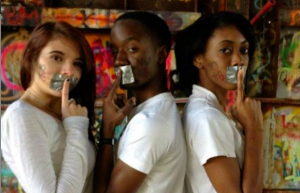
A group of young people sit together in a wooded area.
Imagine you’re attending a potluck with people who are known for their special cooking style and skill.
Pretty cool, right? At the very least, you’ll throw a salad together and get your grub on with everyone else’s dishes. If you’re also into cooking, you’ll show off your skills for people who will appreciate them.
You could compare this potluck to the multicultural landscape of the United States. Our society includes many races, cultures, and ethnicities. Ever since the 1780s, the metaphor of the “melting pot” has been used to refer to how our groups come together.
The idea behind the melting pot is that our cultures are supposed to blend in harmony, rather than remaining separate, so that we all have equal opportunities.
Let’s think about how this would go down at the potluck.
There are delectable chocolate cupcakes, frosting whipped and shaped to perfection. Jalapeño poppers that would bring a tear to anyone’s eye. Curry with an aroma that makes your mouth water.
But before anyone can even get a taste, someone dumps everything into one giant pot and boils it all together.
The immaculately-shaped chocolate frosting melts into the curry. The jalapeño poppers unpop, leaking spicy cheese into the mix. Salads, side dishes, and entrees disappear into the sloppy mess.
Even the meal you worked hard to make (or bought at the grocery store – hey, I’m not judging) plops into the pot. And to top it all off, someone pours in a bottle of fish oil, so the whole thing smells like it’s bubbling up from the ocean through the sewer.
Not so appetizing now, is it?
People try to reassure you. “It’s a melting pot! The best way to taste everything.”
If you have your doubts, I don’t blame you. The skeptical expression you’re giving this potluck is probably similar to the look on my face when people describe the US as a “melting pot.”
When you’re sampling different meals, you probably want to appreciate what they each have to offer, rather than losing all of the flavors to one.
In the same way, while it’s great to have people of different cultures co-exist peacefully, that shouldn’t have to mean erasing the unique aspects of our cultures.
Maybe your teachers or family taught you the melting pot image. It can seem like a nice idea, but what we know now about culture and identity shows that it’s not working as a metaphor for our society.
Still, we keep passing it on, generation after generation – and it’s telling that I often come across the melting pot argument from white people trying to dismiss anti-racist activism.
If you believe that the US is a melting pot, you might even consider yourself anti-racist – much like the potluck attendees, you think blending our cultures is a good thing.
So when you encounter spaces designated only for people of color, or traditions we try to protect from cultural appropriation, you think we’re going about anti-racism all wrong.
You wonder: Isn’t coming together as one human race the whole point of equality?
It makes sense that you’re having trouble understanding our perspective – because learning that the US is a melting pot also requires learning several other myths.
Let’s get to the truth behind some of these lies about race, culture, and identity. Then, hopefully we can find a metaphor that better represents our experiences – and doesn’t erase our identities.
Myth #1: Everyone Is Treated Equally
For the melting pot idea to be sound, we’d have to be living in a world without oppressive systems that treat people differently based on their identities.
After all, that was the whole idea behind the melting pot theory. When it became popular at the turn of the 20th century, it was part of the “American Dream,” paired with images of the Statue of Liberty to convey the idea that immigrants were welcome to our “land of opportunity” to pursue their happiness.
But, as you can probably imagine, “equality for everyone” was far from the reality of the early 1900s – and it doesn’t belong in travel brochures for the US these days, either.
For instance, if we were really living in a post-racial society in which all things are equal, our media would reflect that.
Instead, the mainstream media does an awful job of representing racial and ethnic diversity. White actors consistently get far more visibility and awards than actors of any other race.
Why does this matter, when it comes to whether or not our society is truly a harmonious melting pot?
For one example, consider how you probably don’t assume that white Americans are immigrants. A common phrase used to “define” white Americans’ ethnicity is: “I’m not anything – I’m just white!”
But Asian Americans get asked “Where are you really from?” all the time.
If you hardly ever see Asian Americans in the media, and they’re stereotyped as weird “foreigners” when you do see them, it’s no wonder that they don’t come to your mind when you think of what it means to be “American.”
Our society still has everyday examples of racism like microaggressions, not to mention racial bias and stereotyping in institutions like the media.
So when you think of a metaphorical melting pot as positive, know that not everyone can “blend” into a position of equal opportunity. Some of us are always visibly marked as “other,” no matter what we do.
Myth #2: Everyone Benefits When We Share Our Cultures
What do you like about the idea of sharing across cultures?
Is it the chance to learn from each other? To understand other people’s experiences?
To exploit other people’s struggles and make them more like your idea of “normal”?
That last one probably didn’t make your list – at least not consciously. But if you’ve been taught that sharing our cultures is the key to racial harmony, you might have also been taught some harmful ways of going about it.
I think it’s great when we can share our cultures in ways that foster mutual growth.
The catch is that, just like throwing flavors together at random won’t necessarily result in a tasty meal, trying to share our cultures without being thoughtful about how we do it can be harmful, instead of beneficial.
When we “share” our cultures without considering the impact on marginalized people, it’s usually white people who benefit the most, while other people suffer.
It’s worth noting that there are drawbacks for white people, too – like getting homogenized into one big group instead of recognizing distinct ethnicities.
But with the general concept of “whiteness” as the standard of “normal,” white people usually get the advantage of being considered the default race, while everyone else is considered “different.”
For example, when we label people of color as “ethnic” even though everyone has an ethnicity, that might encourage you to venture into people of color’s restaurants for “exotic” meals – but it doesn’t help your perception of us.
If it did, then women of color would feel deeply affirmed every time a white person flirts with us by focusing on our race.
Instead, people interested in our “ethnic flare” often fetishize Latina women as “spicy,” Asian women as exotic, submissive dolls, and Black and Native women as hypersexual – leaving us feeling dehumanized and objectified.
Our society’s biased approach to ethnicity encourages you to exotify and objectify people of color by enjoying the parts of our cultures that you like and reducing us to stereotypes – instead of recognizing us as full human beings.
White people acting on this encouragement don’t “normalize” our identities at all.
So, what are the options for a woman like me to be treated as a normal person?
Should I try lightening my skin, as so many dark-skinned women are pressured to do? Straighten my hair, so people stop treating it like a strange fascination?
Should I try to attain a white standard of beauty, distancing myself so much from Blackness that people will tell me “I don’t even see you as Black”?
If society really supports everyone “belonging” here no matter who we are, then I shouldn’t have to be as white as possible to be treated like a human being instead of an “ethnically interesting” object.
There’s no benefit in that for people of color at all.
Being different isn’t an inherently bad thing. Nobody should be penalized just for not fitting the dominant norm.
Myth #3: We Have to Dabble in Other Cultures to Appreciate Each Other as People
If you’re interested in a melting pot society for the sake of racial equality, then you should be interested in what people of color have to say about how you can best support us.
But when anti-racist allies insist on “appreciating” other cultures in ways that actually hurt people of color, that’s a clear sign that it’s not really about respecting us as people.
For example, some white people argue that designating spaces only for people of color is an act of “reverse racism.”
Because POC-only spaces go against the melting pot idea, right? How can we share our world in harmony if white people are excluded from some spaces?
Villainizing or insisting on invading POC-only spaces is an example of how you can claim to have interest in a culture, while at the same time completely erasing the needs of its people.
You’re imposing your perspective of what it takes to create racial harmony – without even listening to the people you’re supposedly trying to create harmony with.
If you listen to the reasons people of color create spaces for ourselves, you won’t find “reverse racism” among them.
You’ll find that people of color can get some forms of healing and self-care only in our own communities. And you might learn about how spaces you think are “welcoming” are actually catering to white folks, so we feel excluded from them all the time.
This isn’t about some arbitrary hatred for white people – it’s the result of living in a society where racial inequality is so pervasive.
But you’re not invited to consider all of that when you’re taught that the US is a melting pot.
You’re actually encouraged to look down on people of color when we’re not properly assimilating – even when we’re telling you that space to connect with our own culture is what we need.
Myth #4: Encouraging Assimilation Means Encouraging People to Be Successful
It’s ironic that popularizing the melting pot theory was all about “welcoming” immigrants into white American culture – especially considering that the US was born out of the invasion and genocide of Native land and people.
Taking over someone else’s land, and then demanding that people conform to your culture? That’s just wrong.
But you might think assimilation isn’t such a bad thing. Does ditching the melting pot model mean we focus too much on race, on differences between us instead of our similarities?
If you’re encouraging people to do what they can to be considered “normal,” does that amount to giving them tools to get ahead?
It may seem like a good idea to open the doors for indigenous people, immigrants, and people of color to access the social, political, and economic opportunities that can come with fitting into the dominant culture.
Except that under the melting pot model, accessing these opportunities requires those who aren’t white Americans to change ourselves.
This relates to the “bootstraps” mentality – the idea that anyone can work hard and pull themselves up into wealth and opportunity.
But what you end up doing is blaming the victims of unequal systems, shaming them for being unable to overcome a system designed for their failure.
A lot of the ways that we normalize whiteness become invisible if we don’t consciously think about them. For instance, we don’t question what we believe to be “normal” standards of professionalism, even though they enforce perceptions of the traditions of people of color as abnormal.
Again, if any form of “sharing” cultures was supportive, then you’d think that you could find some of the strongest allies to indigenous people at music festivals and Washington Redsk*ns football games. These settings consistently have non-Native people appropriating Native cultures.
But instead of allies, you’ll find non-Native people with no consideration for Native activists protesting their dehumanizing, stereotyping behavior.
Meanwhile, Native people face systemic barriers to economic opportunities – especially when they follow the traditions stereotyped as “savage,” “unprofessional,” and meaningless fashion trends.
If you’re wondering why Native people living in poverty don’t just “pull themselves up by the bootstraps,” those stereotypes can give you a hint of what’s getting in the way.
Instead of putting the responsibility on marginalized people to assimilate into white American norms, we should be working to change the systems that punish us for being ourselves.
***
So the United States isn’t the harmonious melting pot you thought it was. And it turns out it’s harmful to offer “equal opportunities” to those who blend into white American culture, instead of appreciating the beauty of diversity.
Can you think of another metaphor that might be more fitting?
Some sociologists have developed the concept of the “salad bowl,” which would allow diverse cultures to be visible without being homogenized into one.
These concepts can help, but it’s important to focus on the truths behind them, and stay open to changing our approach as we learn more about what marginalized cultures need.
Personally, I’m less concerned about getting the metaphor right and more interested in how we actually treat each other.
And as a Black woman who’s been othered and fetishized as “chocolate” more times than I can count, I’m kind of tired of being compared to food.
My vision of a truly just society includes treating people as people and our cultures as valuable – not something shameful to melt away into white American norms.
So the next time you think of the US as a melting pot, consider who’s being hurt by and excluded from that image. And try to understand why we must resist getting dumped into the pot.
[do_widget id=’text-101′]
Maisha Z. Johnson is the Digital Content Associate and Staff Writer of Everyday Feminism. You can find her writing at the intersections and shamelessly indulging in her obsession with pop culture around the web. Maisha’s past work includes Community United Against Violence (CUAV), the nation’s oldest LGBTQ anti-violence organization, and Fired Up!, a program of California Coalition for Women Prisoners. Through her own project, Inkblot Arts, Maisha taps into the creative arts and digital media to amplify the voices of those often silenced. Like her on Facebook or follow her on Twitter @mzjwords.
Search our 3000+ articles!
Read our articles about:
Our online racial justice training
Used by hundreds of universities, non-profits, and businesses.
Click to learn more




















